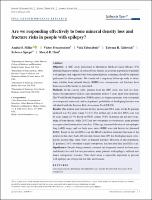Please use this identifier to cite or link to this item:
https://hdl.handle.net/20.500.12202/5571| Title: | Are we responding effectively to bone mineral density loss and fracture risks in people with epilepsy? |
| Authors: | Miller, Amitai S. Ferastraoaru, Victor Tabatabaie, Vafa Gitlevich, Tatyana R. Spiegel, Rebecca Haut, Sheryl R. |
| Keywords: | bone mineral density dual-energy absortiometry scan Fracture Risk Assessment Tool osteoporosis fracture |
| Issue Date: | 6-Apr-2020 |
| Publisher: | Wiley Periodicals Inc. on behalf of International League Against Epilepsy. |
| Citation: | Miller AS, Ferastraoaru V, Tabatabaie V, Gitlevich TR, Spiegel R, Haut SR. Are we responding effectively to bone mineral density loss and fracture risks in people with epilepsy?. Epilepsia Open. 2020;00:1–8. https://doi.org/10.1002/ epi4.12392 |
| Series/Report no.: | Epilepsia Open;6 April 2020 |
| Abstract: | *****Objective: A 2007 study performed at Montefiore Medical Center (Bronx, NY) identified high prevalence of reduced bone density in an urban population of patients with epilepsy and suggested that bone mineralization screenings should be regularly performed for these patients. We conducted a long-term follow-up study to deter- mine whether bone mineral density (BMD) loss, osteoporosis, and fractures have been successfully treated or prevented.--- *****Methods: In the current study, patients from the 2007 study who had two dual- energy absorptiometry (DXA) scans performed at least 5 years apart were analyzed. The World Health Organization (WHO) criteria to diagnose patients with osteopenia or osteoporosis were used, and each patient's probability of developing fractures was calculated with the Fracture Risk Assessment Tool (FRAX).----- *****Results: The median time between the first and second DXA scans for the 81 patients analyzed was 9.4 years (range 5-14.7). The median age at the first DXA scan was 41 years (range 22-77). Based on WHO criteria, 79.0% of patients did not have wors-ening of bone density, while 21.0% had new osteopenia or osteoporosis; many patients were prescribed treatment for bone loss. Older age, increased duration of anti-epileptic drug (AED) usage, and low body mass index (BMI) were risk factors for abnormal BMDs. Based on the first DXA scan, the FRAX calculator estimated that none of the patients in this study had a 10-year risk of more than 20% for developing major osteo- porotic fracture (hip, spine, wrist, or humeral fracture). However, in this population, 11 patients (13.6%) sustained a major osteoporotic fracture after their first DXA scan. Significance: Despite being routinely screened and frequently treated for bone min- eral density loss and fracture prevention, many patients with epilepsy suffered new major osteoporotic fractures. This observation is especially important as persons with epilepsy are at high risk for falls and traumas. |
| Description: | Full-length original research. ORCID Amitai S. Miller https://orcid.org/0000-0001-6130-6810 |
| URI: | https://doi.org/10.1002/epi4.12392 https://onlinelibrary.wiley.com/doi/full/10.1002/epi4.12392 https://hdl.handle.net/20.500.12202/5571 |
| ISSN: | 2470-9239 |
| Appears in Collections: | Student publications |
Files in This Item:
| File | Description | Size | Format | |
|---|---|---|---|---|
| Miller et al. EPI4_12392_Rev_EV.pdf | 198.52 kB | Adobe PDF |  View/Open |
This item is licensed under a Creative Commons License

